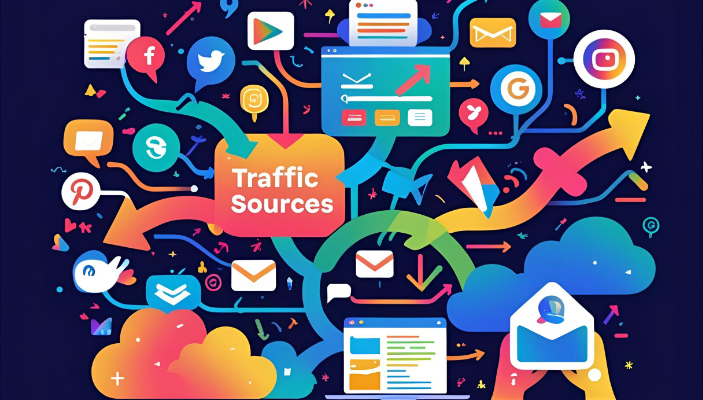In 2025, relying solely on Google to drive traffic to your blog isn’t just risky—it’s limiting your blog’s full potential. Search engines are powerful, but diversifying your traffic sources brings resilience, broader audience reach, and greater control.
In this article, we explore the most effective traffic sources outside of Google that can bring consistent, high-quality visitors to your blog. You’ll learn what platforms work, why they matter in 2025, and how to build a strategy that puts your readers first.
Why Google Isn’t the Only Answer Anymore
For years, Google has been the default gateway for web traffic. But in 2025, content saturation, shifting algorithms, and ad-heavy search results are pushing bloggers to diversify. Many creators now build loyal audiences through platforms that prioritize relationships, intent, and engagement—rather than keyword positioning.
Here’s why expanding beyond Google makes sense:
- Algorithm unpredictability: Google updates can tank traffic overnight.
- Ownership of audience: Platforms like email or communities give you more control.
- Better engagement: Some channels offer more targeted traffic and loyal followers.
Let’s explore where that traffic can come from—strategically and sustainably.
1. Email Newsletters [Direct Reader Access]
Email remains a powerhouse in 2025. Unlike social media, you own your list, and every email goes directly to someone interested in your content.
How it helps:
- High open and click-through rates.
- Builds reader loyalty over time.
- Not influenced by third-party algorithms.
What works:
- Weekly newsletters with fresh blog summaries or bonus insights.
- Lead magnets (free downloads, checklists) for list building.
- Platforms like Beehiiv, Substack, or ConvertKit for monetization and delivery.
Tip: Segment your audience to personalize your messages. This boosts trust and encourages more repeat visits to your blog.
2. Pinterest [Intent-Focused Visual Traffic]
Pinterest in 2025 acts more like a visual search engine than a social media platform. It brings evergreen traffic with high intent—people search Pinterest when they’re ready to learn or act.
How it helps:
- Posts live for months or years.
- High conversion for lifestyle, wellness, travel, finance, and DIY blogs.
- Drives traffic without relying on follower count.
What works:
- Vertical graphics with strong headlines and branding.
- Consistent pinning with Tailwind or native Pinterest scheduler.
- Linking directly to blog posts with clear call-to-actions.
Tip: Pinterest’s algorithm rewards consistency. Focus on regular content updates and keyword-optimized pin descriptions.
3. Reddit [Real Conversations, High Trust]
Reddit is underrated but potent. Niche communities (subreddits) are filled with users actively seeking genuine advice, ideas, and insights.
How it helps:
- Highly targeted audiences.
- Honest feedback and discussions.
- Low competition compared to major platforms.
What works:
- Adding value in conversations without pushing links.
- Building a presence by contributing first, sharing later.
- Sharing blog links only when contextually relevant.
Tip: Focus on subreddits that align with your blog niche. Comment regularly and be transparent about your background.
4. Quora & Question-Based Platforms [Search-Intent Amplifier]
Platforms like Quora, Stack Exchange, or niche Q&A forums allow you to reach people actively seeking knowledge.
How it helps:
- Evergreen answers can bring traffic for years.
- Boosts your authority as a thought leader.
- High engagement from real users.
What works:
- Writing thorough answers with helpful context.
- Linking to your blog post only when it adds clear value.
- Targeting trending or unanswered questions.
Tip: Use Google Search Console or tools like AnswerThePublic to find recurring questions that align with your blog’s topics.
5. YouTube Shorts & Medium-Form Videos [Content Repurposing]
Video continues to dominate attention in 2025. Short videos—30 to 90 seconds—are the gateway to introduce your blog to wider audiences.
How it helps:
- Builds familiarity and face recognition.
- Algorithm pushes high-performing videos for extended periods.
- Great for converting viewers into email subscribers or blog readers.
What works:
- Summarizing blog posts into short insights.
- Using clear hooks and captions.
- Posting consistently on YouTube, Instagram Reels, or TikTok.
Tip: Add your blog link in the bio and mention it naturally in your video content to encourage visits.
6. Medium & Partner Blogs [Platform Syndication]
Republishing or adapting blog content to publishing networks like Medium helps expand reach and authority.
How it helps:
- Large built-in audience.
- Search visibility within the platform.
- Monetization potential via partner programs.
What works:
- Syndicate top-performing blog posts.
- Add links back to your site or newsletter.
- Publish consistently and engage with reader comments.
Tip: Use canonical tags to avoid SEO issues when cross-posting content.
7. Twitter/X Communities [Real-Time Topic Reach]
Twitter (now X) still works well for idea-sharing and real-time updates. In 2025, niche communities (Topics & Lists) help you stay connected with the right audience.
How it helps:
- Quick feedback loops.
- Real-time engagement.
- Drives readers to time-sensitive blog content (e.g., news, trends).
What works:
- Share micro-insights from your blog.
- Create threads summarizing blog points with a CTA link.
- Join relevant Spaces or Topic Lists.
Tip: Treat Twitter like a micro-blog. Each tweet should offer value—even without a link.
8. LinkedIn for Niche and B2B Blogs
LinkedIn has grown beyond just resumes. In 2025, it’s a vibrant ecosystem for professional, industry-specific content.
How it helps:
- High engagement for niche and expert-level blogs.
- Great for thought leadership and case studies.
- Native articles build brand trust.
What works:
- Sharing blog snippets as LinkedIn posts or articles.
- Commenting on industry posts to spark interest.
- Engaging directly with your target audience.
Tip: Use storytelling and personal experience in your posts—it performs better than formal promotion.
9. Facebook Groups [Community-Driven Reach]
While organic Facebook Pages have weakened, Groups still deliver excellent engagement—especially for personal development, parenting, finance, and wellness blogs.
How it helps:
- Hyper-targeted discussions.
- Easier trust-building.
- Stronger relationship with audience.
What works:
- Join and contribute to existing groups.
- Start your own Facebook Group for your blog’s niche.
- Share links only when they provide true value.
Tip: Use polls or questions to encourage member engagement and understand their interests.
10. Push Notifications [Instant Re-Engagement]
Push notifications—web-based alerts—offer direct, real-time access to your readers without relying on email or algorithms.
How it helps:
- Instant click-throughs.
- High opt-in for loyal readers.
- Drives repeat traffic.
What works:
- Send updates when publishing new blog posts.
- Keep messages short and urgent.
- Use tools like OneSignal or Subscribers.
Tip: Don’t overuse. One alert per post is enough to maintain interest without fatigue.
Bringing It All Together: Building Your Diversified Traffic Strategy
A sustainable traffic strategy in 2025 isn’t about chasing the next viral platform—it’s about balance. Here’s a simplified framework to get started:
1. Own Your Audience
Focus on email and push notifications first. These are reliable and offer the most control.
2. Build on Platforms That Grow with You
Pinterest, YouTube, and Medium can bring consistent traffic with the right effort.
3. Engage Where Conversations Happen
Reddit, Twitter, Quora, and LinkedIn help you build authority and community trust.
4. Track and Adjust
Use UTM parameters and analytics tools to see what works. Prioritize quality visitors over quantity.
By understanding how your audience behaves, where they spend time, and how they interact with content, you can craft a traffic strategy that not only grows numbers—but builds a meaningful relationship between you and your readers.
Final Thoughts
In 2025, the best traffic source is not just one channel—it’s the ecosystem you build around your content. Focus on platforms that connect you with real people, not just algorithms. The more intentional your distribution strategy, the more likely your blog is to stand out, serve, and succeed long-term.
Whether you’re a solo blogger, part-time writer, or a full-time publisher, putting people before platforms will always bring the most valuable traffic.
5 Short FAQs
1. What’s the most reliable traffic source after Google?
Email newsletters are among the most reliable because they give you direct access to your readers without relying on algorithms.
2. Is Pinterest still relevant for blogs in 2025?
Yes, especially for visually appealing and evergreen niches like lifestyle, travel, and DIY.
3. Can Reddit bring consistent blog traffic?
Yes, if used authentically. Focus on contributing value in niche subreddits before sharing links.
4. How do push notifications help blogs?
They re-engage past visitors and notify subscribers instantly when you publish something new.
5. Should I post full blog content on Medium?
You can, but use canonical tags or summaries that link back to your original blog to avoid SEO duplication.
ALSO READ






![7 AI Trends for 2025 Businesses Must Track [AI Strategy]](https://blogss.online/wp-content/uploads/2025/07/7-AI-Trends-for-2025-Businesses-Must-Track-.png)

[…] Best Traffic Sources for Blogs in 2025 […]